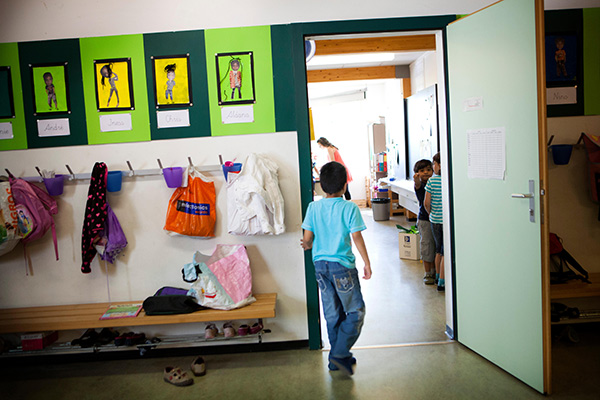Subtotal: $
Checkout
The School Principal’s Prayer
Like monks of old, I walk the halls, not to get anywhere, but to stay close to what matters.
By Brandon McNeice
August 13, 2025
Most mornings, after I step through the front doors of the school I lead, I begin to walk.
Not with any dramatic purpose, just a quiet loop through the building before the day gathers its momentum. I pass the chipped tile by the front office, the one that catches the edge of your shoe if you’re not paying attention. The custodian is already making a second sweep of the cafeteria. A bulletin board outside Room 108 features snapshots of faculty and students who have birthdays this month. Some are smiling wide, others clearly caught off guard. The laminated heading reads This Month We Celebrate You, and a few of the photos are slightly crooked. I haven’t asked anyone to straighten them. There’s something perfect about the way they lean.
These small things – the tile, the light, the birthday board – quiet me. Before I’ve spoken a word or answered a single email, I’ve remembered where I am, and maybe more importantly, how I want to be in this place.
Some days, I think of monks.
The monks of old walked their cloisters not to get anywhere, but to stay close to what mattered. Their feet pressed the stone not in pursuit, but in reverence. It wasn’t about movement, it was about formation. They walked the same path each day so that the path could work on them.
I walk linoleum instead of limestone. I carry a walkie-talkie, not a breviary. My shoes are sensible, not symbolic. Still, this daily walk through the halls has become a kind of ritual. Not a performance, but a posture. Not an escape, but a return.

Photograph by Amelie Benoist / Alamy Stock Photo.
School leadership is built on interruption. The day unfolds in fragments. Someone asks for my keys. A student needs gloves from the lost and found. A teacher pulls me aside to check whether I’ve had a chance to read the email about the late bus. I haven’t, not yet. There are birthdays to remember, allergies to accommodate, a surprise fire drill to coordinate. And still, I walk.
It’s not glamorous. It’s certainly not efficient. But grace, I’ve found, doesn’t operate on efficiency.
One morning, I paused outside a classroom just as a student crouched to help a peer gather loose papers that had scattered across the hallway. No one else noticed them. There was no instruction to help, no reward offered. It was a quiet exchange, barely a few seconds long, but it stayed with me. A deeply human gesture of kindness carried out without fanfare.
These are the moments I watch for.
Down the hall, a first grader once asked if trees ever get lonely. I said I wasn’t sure, and they nodded solemnly, as if that made sense. Outside Room 203, a student taped a hand-drawn heart to the door with the words “For anyone who needs one.” In the stairwell, a seventh grader lingered to help a kindergartner tie a shoe, saying nothing, just assisting until it was done. None of these moments show up in strategic plans or progress reports, but they are the quiet curriculum that teaches us what it means to belong to one another.
The Benedictines had a phrase, ora et labora, pray and work. Not one in service of the other, but together, woven into one rhythm. They believed that if you sweep a floor with love, it is no less sacred than singing a hymn. I think of that when I stop to listen to a staff member vent without rushing to fix anything. Attention, when given freely, is already a form of prayer.
Over time, I stopped thinking of this walk as something I do for the school. I started seeing it as something the school does for me. It slows me down. It reorients me. It reminds me that leadership isn’t about being seen or heard, it’s about being present in the right ways at the right times. Not to manage from a distance, but to be near enough to notice.
To lead, I am learning, is not to ascend but to remain. It is not to speak first but to listen. It is to see without needing to be seen, to walk not toward control, but toward care. Some days, I forget. I move too fast. I check my phone during conversations. I hide behind tasks and let the day slip by in pieces. But then there are mornings like this one, when the heater hums softly, and the floors are freshly waxed, and the building feels like it is waiting to be walked with reverence.
There is something sacred in repetition. A way of saying, I’m still here. A way of saying, this place matters. A way of choosing, again and again, to return.
I think the monks understood this. That to walk the same path each day is not just habit. It is an act of becoming. The path, if you let it, will shape you.
These halls are imperfect. They echo with locker slams and pencil sharpeners, laughter and tears, sneakers on tile, and the distant crackle of announcements. But they are also full of grace. You just have to walk slowly enough to see it. In the child who gives half a cookie to a friend. In the teacher who rewrites a lesson after a long day because they believe tomorrow might be better. In the parent who arrives late but still kneels to zip up a backpack. These, too, are prayers.
I don’t burn incense. I don’t chant psalms. I carry a coffee I rarely finish and a crumpled list of reminders stuffed in my coat pocket. But I carry something else as well, something quieter. A belief that this work, done well and done with care, is sacred. That the repetition of walking, greeting, noticing, listening, and helping is not incidental, it is the point.
Holiness does not only live in cathedrals or mountaintop moments. Sometimes it lives in dropped papers and birthday boards, in the way someone straightens a stack of chairs or refills the soap dispenser without being asked. Sometimes it lives in the act of returning, again and again, to a small and noisy place, and saying with your body, this is worthy of love.
Even linoleum, walked with love, can become holy ground.
Already a subscriber? Sign in
Try 3 months of unlimited access. Start your FREE TRIAL today. Cancel anytime.







Michael Dean
Thank you so much for this insightful writing, Brandon. I have nearly wept that our churches have almost forgotten this. "There is something sacred in repetition....That to walk the same path each day is not just habit. It is an act of becoming. The path, if you let it, will shape you." For planning worship I have latched on to a phrase: "We shape the liturgy then the liturgy shapes us." It is through this repetition that we, slowly, learn to inhabit practices that begin to shape us. We need more than intellectual assent, we need embodied participation in sacred practices. "Even linoleum, walked with love, can become holy ground." Everything, done with love, become holy.
Alliee DeArmond
Ah, wonderful starting off the day with the notion that work IS prayer. They are not a dialectic, not two opposing concepts: work OR pray. Rather they are like the right and left foot, both which are needed together in order to walk.
Susan Stephens
Oh Brandon. Thank you! I was just hunting down Tennyson's quote, "More is wrought by prayer than the world dreams of...", and had stumbled over the World Mission Prayer League site, when there off to the left was the Daily Dig and your article. What a morning! :)